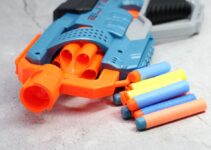There are a lot of above-ground pools on the market, and they’re not all created equal. Choose the right pool, and your family will have a wonderfully convenient way to stay busy, happy, and cool. Choose a dud, and you’ll wish you had spent the money on a boatload of ice pops instead.
Below, you’ll find our list of the best above-ground pools you can buy, so you can make an informed decision.
Table of Contents
- Our Top Picks for the Best Above Ground Pools of 2024
- Frequently Asked Questions
- What is an above-ground pool?
- What shapes and sizes are available?
- How deep are above ground pools?
- Why buy an above-ground pool?
- Are above-ground pools reliable?
- Where should you put an above-ground pool?
- How do you level the ground for the pool?
- What size above-ground pool should I get?
- How do you store an above-ground pool?
- A final note on safety
- So what’s the best pool for your family?
Our Top Picks for the Best Above Ground Pools of 2024
1. Intex Prism Frame (Best Overall)
Price range: $100 to $700
The Intex Prism Frame features powder-coated steel tubing and a 3-ply puncture resistant liner made of UV-stabilized polymer material. There are round, rectangular, and oval models available in different sizes, including 12′ x 30″, 15′ x 42″, and 20′ x 10′ x 48″.
You won’t need any tools to assemble the Intex Prism, which gets high marks in terms of assembly and disassembly. Set-up is hassle-free, and the pump, which has a flow rate of 750 gph, plugs into a regular outlet.
The Prism pool drain port is located at the bottom of the pool and has a threaded cap. Drainage, according to users, is easy.
Along with the frame, liner, and filter pump, the Prism pool kit includes a slip-resistant ladder, ground cloth, debris cover and instructional DVD.
The pool is designed for kids ages 6 years and up, and the kit comes with a 1-year limited warranty. The walls are a muted gray color, which is more discreet than some other Intex pools.
Pros:
- Easy assembly
- Attractive
- Sturdy frame
Cons:
- Pump is insufficient so you will need to upgrade it
Bottom line: If you’re looking for a good-looking, good-quality pool with easy, tool-free assembly, the Intex Prism is a solid option. Some other Intex models are available only in round models, so if you’re specifically looking for a rectangular- or oval-shaped pool, this is the way to go. But be prepared to upgrade to a sand pump, because the pump that’s included is insufficient. And consider using a thick ground cloth, because the liner is somewhat thin.
Click here to see today's price for the Intex Prism Frame on Amazon
2. Intex Metal Frame Pool, (Best for Budget)
Price range: $100 to $500
The Intex Metal Frame Pool is the company’s standard model. It’s super popular, in part because of its relatively low price point.
Available in half a dozen round frame sizes, the Intex Metal Frame Pool is easy to assemble and has a durable feel. The pool has a convenient drain plug that connects to a garden hose, so water can be directed away from the pool area.
As with the Intex Prism, the Metal Frame kit includes a ladder, ground cloth and debris cover. And like the Prism, there are complaints about the cartridge pump that is included with the Metal Frame kit.
The Metal Frame Pool kits come with a 90-day warranty, which is weaker than the Prism’s one-year limited warranty.
Pros:
- Easy assembly
- Low price
Cons:
- Pump is insufficient
Bottom line: For a basic, no-frills, budget-friendly pool that is easy to set up, try the Intex Metal Frame Pool. It’s one of Intex’s most affordable and popular units. Assembly is easy, and the pool comes with some useful extras. The Metal Frame Pool not as durable as the Ultra XRT, which we’ll talk about next, but a lot of folks give this pool full marks. For best results, we recommend upgrading to a better quality pump.
Click here to see today's price for the Intex Metal Frame Pool on Amazon
3. Intex Ultra XTR Pool Set(Best Durability)
Price range: $600 to $1900
The Intex Ultra XTR Pool frame is made of rust-resistant galvanized steel and features t-joint connectors and an easy locking system. Along with the frame, liner, and pump, the pool kit includes a removable ladder, sand filter, debris cover and ground cloth.
The unit comes with a 2-year manufacturer’s warranty, which is considerably more generous than the Intex Metal Frame and Intex Prism.
Customers like the durable feel of the Ultra XTR frame and liner, which is crafted from puncture-resistant polyester mesh and heavy-gauge PVC. The company claims the Ultra XTR liner offers 50 percent more tear resistance than the Metal Frame liner.
The Ultra XTR frame is galvanized and powder coated to ward off rust. Unlike Intex Prism and Intex Metal Frame Pools, the Ultra XTR comes with an upgraded sand filter pump, which is a big step up from the standard Intex cartridge pump. The upgraded pump has a handy timer function, and it does a much better job keeping the pool water clear and clean.
Pros:
- Heavy-duty pool liner
- Two-year warranty
- Sand filter pump
Cons:
- Cover blows off
- Mid-quality ladder and ground cover
Bottom line: If you like the easy assembly of Intex pools but want a more durable liner, a more effective pump, and a more generous warranty, go with the Intex Ultra XTR. Pool set-up is easy, and the sand pump and filter system do a far better job than the standard pumps included with the Metal Frame and Prism models.
Click here to see today's price for the Intex Ultra XTR on Amazon
4. Intex Baby Splash Pool (Best for Small Spaces)
Price range: $85 to $110
The Intex Baby Splash Pool is great for younger kids or a small group of adults. Sturdier than an inflatable pool and yet super easy to set up, this is also a great option for people with limited outdoor space.
The pool frame is constructed from powder-coated steel to keep rust at bay, although we did see some complaints about parts rusting out. The sidewalls are laminated and reinforced to stabilize the legs. Unlike round pools or rectangular inflatables of similar size, this one offers convenient corner surfaces, so you can keep your sunglasses or a water bottle within reach.
You can connect a standard garden hose to the drain plug, which allows you to control the direction of drainage away from the pool or your house. Unfortunately, the drain plug is high up on the side of the pool. Users complain that it’s hard to drain the pool completely without scooping out the last few inches of water or lifting the sides of the pool and pouring.
This rectangular pool might be on the small size, but it does hold up to 439 gallons of water. And we heard from users that four to six adults can relax comfortably in it.
Pros:
- Compact size
- Easy set-up and storage
- Connects to garden hose
Cons:
- Some rust and leaking
- Drain location
- No pump or accessories included
Bottom line: This pool is a great value if you’ve gotten limited yard space or if you’re specifically looking for a small unit. You’ll need to invest in a pump and other accessories, and be prepared to deal with a less-than-perfect drain design.
Click here to see today's price for the Intex Baby Splash Pool on Amazon
5. Homech (Best Inflatable)
Price range: $110 to $120
The Homech Inflatable Pool is one of the better, sturdier inflatables currently on the market, and it’s larger than a typical blowup wading pool. Made of good-quality PVC, the pool has three individual air chambers stacked one on top of the other. Its design offers a decent 22-inch depth and makes it easier to limit and control leakage.
The pool inflates quickly and easily, even with a manual or foot pump. A good quality electric pump can take care of the job in under five minutes.
The Homech holds air well and is resistant to tears, leaks, and rips. There have been some reports of leakage, usually in just one of the chambers, but the pool’s 0.4mm thick walls are pretty durable .
Homech inflatables are large enough for two adults to sit comfortably or for several little swimmers at a time, which is perfect for some families. Make sure you consider the dimensions carefully before you buy; some users have been disappointed by the small size. Deflation takes some time, but once the air is out, the unit folds up nicely for convenient storage between uses.
We like the fact that the pool is BPA-free and has multiple safety certificates, including ASTM.
Pros:
- Easy set up
- Easy to drain
- 12-month warranty
Cons:
- Pricey for an inflatable
Bottom line: If you don’t want to fuss with setting up a frame and you want an inflatable unit with just enough room for a few kids and adults, the Homech is a great option. Plan to keep it in a large plastic storage bin between uses, because you won’t manage to get it back in the box after you deflate it. If you have space in your basement, family room, or playroom, the Homech can double as an indoor ball pit.
Click here to see today's price for the Homech on Amazon
What is the largest above-ground pool?
At the time of this writing, the largest above-ground pool you’ll find is the 32′ Intex Ultra XTR. We reviewed the Intex Ultra XTR above, and this one has all the pros and cons of the smaller units. It’s rectangular in shape, it measures 32′ x 16′ x 52′, and it can be purchased with a sand filter pump and saltwater system.
In a word, it’s…huge.
Click here to see today's price for the Intex 32 x 16 x 52 Ultra XTR Pool on Amazon
Frequently Asked Questions
What is an above-ground pool?
As the name implies, above-ground pools are designed to sit on the surface of the ground. In-ground pools involve carving out a sizeable chunk of your yard. Although you might need to do some work to achieve a level surface, above-ground pools are relatively non-invasive.
Above-ground pools are generally easy to assemble, and the process of setting up the pool often takes less time than it takes to fill with water.
There are three primary types of above-ground pools:
Metal-frame
Metal-frame pools are particularly popular. They’re relatively easy to assemble and offer greater durability than inflatables. Assembly of metal-frame pools involves installing the frame pieces, stretching a pool liner over the frame, and then securing the liner in place.
Rigid-wall
Pools with rigid sides consist of a rigid structural wall and a vinyl liner. The walls themselves are generally constructed of steel, a combination of steel and resin, or aluminum. Steel and aluminum are both susceptible to rust. Pure resin is generally resistant to rust, oxidization, and erosion. It tends to holds up well to heat, especially if it is treated with a UV-resistant coating. Resin that isn’t properly treated can flake and crack.
Inflatable
Inflatables make good starter pools. Good ones can be an absolute joy to set up, because all you need is a decent air pump. Inflatable pools tend to be the least expensive of the three types. They’re also the least durable, and you’ll be more limited in terms of size and depth.
What shapes and sizes are available?
Unlike in-ground pools, which are highly customizable, above-ground pools are generally sold as kits and have pre-determined sizes and shapes. You’ll find a lot of size options, but your choice of shape is pretty much limited to round, rectangular, and oval. Keep in mind, oval pools are basically rectangular but with rounded corners.
Round pools generally range in size from 10- to 24-feet in diameter. Rectangles and ovals range from 12′ x 24′ to 11′ x 33′.
How deep are above ground pools?
Above-ground family-size pool depths typically range from 48″ to 54″. Inflatables offer considerably less depth. The model we reviewed below is 22″ deep.
When choosing a depth, keep in mind, your water level will typically be about 6″ lower than the height of the pool wall.
Why buy an above-ground pool?
In short…convenience and cost. You’ll save yourself the hassle and cost associated with a family pool membership.
Above-ground pools offer other benefits as well. Most models are easy to set up and maintain, they can be relocated to different areas of your yard (or to a new home if you move), and they can be disassembled and stored during the off-season.
How much do above-ground pools cost?
There’s a big range in price based on quality and size. Pools can be as inexpensive as $100 or cost into the thousands.
Are above-ground pools reliable?
A lot of customers are thrilled with the quality of their above-ground pools. However, with off-the-shelf models such as the ones I’ve reviewed below, leakage is not uncommon. First and foremost, these pools are designed for easy assembly and affordability, not for long-term reliability. Especially with cheaper models, there seems to be a good deal of luck involved. Some customers have no problems with holes; others seem to be plagued by them.
If you want to get years of use out of your pool, I recommend you pack it carefully away during the winter months and then reassemble it when the weather turns warm.
Where should you put an above-ground pool?
To avoid serious headaches, choose and prepare your exact pool location carefully.
We recommend setting up your pool as close to your house as possible. Doing so will be more convenient and more comfortable for everyone. You, your kids, and your guests will appreciate the proximity to bathrooms, drinks, clean towels, and other essentials.
Here are some additional considerations:
Level ground: The ground beneath your pool should be perfectly level, flat, dry, and compact. Placing the pool on ground that isn’t level can cause one side to blow out or collapse. You want to avoid sloped areas and muddy, sandy, and soft spots. You’ll also want to remove agressive grasses before setting up your pool. Such grasses, including St. Augustine and Bermuda, can poke through pool liners and destroy their integrity. We’ll talk more about leveling in a minute.
Access to water and power: Your pool needs to be near sources of water and electricity. And if you plan to use the pool at night, make sure you have access to proper lighting.
Good drainage: Try to choose a spot where water will naturally drain away from the pool.
Trees and shrubbery: If possible, choose a location that is far from trees and shrubs. Having leaves, twigs, and other lawn debris nearby can make it difficult to keep your pool clean.
Safety barrier: Safety should always be your foremost concern. The vertical walls of your above-ground pool do create something of a barrier for small children and animals, but if you keep your ladder set up or if children in your neighborhood might find others ways to access your pool, you need to erect a sturdy fence or other safety barrier to keep them out. The area that you choose for your pool should allow for this.
How do you level the ground for the pool?
After you’ve identified the area you want to use for your pool, you’ll need to prepare the ground. Often, this involves a certain amount of leveling to ensure that the pool sits on a firm, level base. Without a level ground surface, you’ll inadvertantly end up with a deep end and a shallow end. Your cleaning equipment can get caught in the shallower end, and, more importantly, the build up of water pressure in the deeper end can cause the walls of the pool to twist or break, resulting in flooding of your yard.
Expect to spend several hours leveling your pool area. The process takes time.
1. Starve your grass: Several weeks before you set up your pool, make an effort to kill the grass in the area. Spread out a thick tarp that covers the area. If you leave the tarp in place for several weeks, you can suffocate the grass and weeds underneath, making it easier to dig out and remove.
2. Mark off the perimeter of your pool area: You can do this by placing a stake in the middle of the area, and then attatching one end of a long string to the stake. The string should be about 6 inches longer than the radius of your pool. Then tie a spray paint can to the free end of the string. Pull the string taut, and walk in a circle, spraying paint on the ground as you go. This will mark the perimeter of the area that needs to be leveled.
3. Remove grass from the area: You’ll need a large board and a level, a pick or shovel to remove large rocks, and a sod cutter or rototiller. Use the board and level to determine where you have low and high points and which areas need to be leveled. Remove rocks with the pick or shovel. Use the rototiller or sod cutter to make a clearing, ideally about 2 inches deep so you can add a 2-inch layer of sand. You’re aiming for a nice, flat surface.
4. Add sand: Landscaping companies and garden centers are good sources of sand. Depending on your particular situation, you might need as much as a truckload. Consult with the company that will be delivering, telling them you want enough sand for at least a 2-inch thick layer that spans the entire area of your pool.
5. Prepare your sand: Use a wide rake to distribute the sand, spread grass killer on top, wet the sand with a hose, and then tamp it down. Allow the water to dry overnight. Try to rent or borrow a lawn roller, and when the sand is dry, use it to pack the area down.
6. Put down a base layer: At this point, it’s advisable to lay down a base layer to protect the bottom of your pool from punctures and tears. Consider using a large foam or tarp-like base.
What size above-ground pool should I get?
Size is a highly personal decision that should be based on your individual needs and circumstances.
Having said that, there are four key considerations.
1. Allow for clearance. First, determine the size of your available space. Keep in mind, you need roughly 5 or 6 feet of clearance on all sides of the pool for safety purposes. Plan to treat that area like a safety zone, keeping it clean and clear of debris to prevent slips and falls. That area should also be free of any patio furniture, toys, and other objects that children might use to climb into the pool.
Once you’ve marked off your safety zone, you can determine what would be the largest possible pool your area can accommodate.
2. Think about usage. Next, think about who the pool is for and how you plan to use it. Are you looking for a small pool for little kids? Are you hoping to host adult pool parties? Want to practice swimming strokes? How many people do you envision using the pool simultaneously?
3. Consider loss of yard space. How much of your space are you willing to sacrifice for the sake of your pool? Bigger is generally better when it comes to pools, but you might not want the largest possible pool if it will eat up every square inch of your usable yard.
4. Check your local building code. Some communities require a building permit for pools that meet certain size and depth criteria. Also, local authorities might have rules about how far your pool needs to be from powerlines, septic tanks, and even your own property line. Do yourself a favor, and find out if your community has any specific code requirements and zoning laws that might affect what size pool you purchase and where you place it.
Other considerations
As you hone in on a particular model, consider how hard it is to assemble and disassemble. Does the model you’re looking at tend to rust over time? Do users complain about leakage? Is the drain hole in a sensible spot? Are you going to have to spend additional money on accessories? What type of warranty does the company offer?
How do you store an above-ground pool?
Before storing your pool, make sure it is completely dry to prevent the growth of mold and mildew. Drain all the water, wipe down the sides and bottom with soft towels, or use a wet/dry vac. Make sure to dry the bottom as well, and check carefully for hidden folds or creases where water might be trapped. Let your emptied pool sit in the sun, and if necessary, apply talcum powder to absorb trace amounts of water. Screw the drain cap into place so you’ll find it easily the following season.
When your liner is completely dry, it’s time to fold and roll it. Fold the liner material inward on all sides, and then, with the help of a buddy, pull one side of the pool over to line up with the other side. Repeat this step, continuing to fold the liner in half until you have a long strip measuring about 4-feet wide. Roll the strip as you would a sleeping bag.
If you notice any rust developing on your metal poles, remove it with steel wool and rust remover before storing.
Place the liner and other pool parts in a large storage bin or a new garbage can. Ideally you’ll store the pool at room temperature in a clean, dry area. Make sure your storage area is free of mice, birds or other animals that might chew into the vinyl liner.
A final note on safety
According to a study appearing in the July 2011 edition of “Pediatrics,” the official journal of the American Academy of Pediatrics (AAP), portable pools used at home “pose a significant risk of submersion-related morbidity and mortality to US children.” Take care to protect the safety of your children and other children in your neighborhood.
The AAP recommends using “layers of protection” to ensure kids’ safety. Consider using a combination of secure fencing, pool alarms, and safety covers, and make sure the adults who are responsible for your kids’ care understand the importance of constant, focused supervision.
So what’s the best pool for your family?
If you’re looking for an affordable frame-style pool that performs well and doesn’t stand out like a sore thumb, go with the Intex Prism Frame. A good performer, the Prism is mid-range in terms of price, and it’s available in a variety of shapes and sizes, including rectangular and oval. Plan to buy an upgraded pump.
If you want an Intex, are OK with a round frame, and want to save some money, go with the standard Intex Metal Frame Pool. It’s available in a lot of different sizes, and it comes with useful accessories. As with the Prism, you’ll likely need to purchase a better pump.
For folks who value durability, the Intex Ultra XTR is the way to go. You’ll pay more, but you’ll also get a stronger warranty and a more effective pump.
Parents who are buying their first frame pool, have limited space, or want something that won’t take over the yard can opt for the Intex Baby Splash Pool. It can be great for younger kids or small groups of adults who just want to cool off.
And if you like the convenience of inflatables, go with the Homech. It’s made of BPA-free material, it’s easy to blow up, and it’s one of the bigger inflatables out there.
Stay cool and enjoy!










